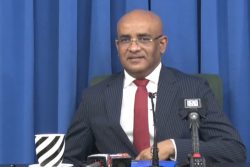Introduction
Last week’s column began a short series on the 2021 financial performance of the three companies – Esso, Hess and CNOOC – which hold 45%, 30%, and 25% respectively of the highly productive Stabroek Block, a find which has placed Guyana on the world’s petroleum map. CNOOC is the newest participant in the arrangement, having paid ExxonMobil in 2014 to acquire a 25% working interest in the Block as a “non-operated joint venture partner”. Why and how CNOOC could pay Exxon rather than the Guyana entity which held the licence is something which no one has yet been able to explain. What this shows is how naïvely reckless Guyana has been in dealings with Esso and why Exxon is seen as dishonest, exploitative, and contemptuous of Third World countries.
CNOOC, like its other two partners, is a branch of a company incorporated outside of Guyana and traces its parent to the People’s Republic of China.
The company reported net income before income taxes of $84,472 million, an increase of 808.5% over 2020 on Net Sales of $127,494 million, which grew by a more modest 207.8%. The Branch reports expenditure on exploration activities of $3,623 million which runs counter to its self-description as a “non-operated joint venture partner”, reflecting the absence of ringfencing in the Agreement and the failure by the government in granting unconditional production licences, at best gross irresponsibility on its part.
Operating costs of $18,570 million was 14.5 % of revenue down from 40.7%, showing the impact of oil price on the performance of oil companies and more so the bonanza which oil companies are reaping.
Then the Statement gets more interesting. Form the net income, the Statement shows a deduction of $21,118 million as Deferred income tax which it does not and will never pay, despite the rather misleading statement in the notes that it is “subject to the Guyana income tax act.” That nonsensical position is further maintained with the statement that at the end of 2021, the company had a deferred tax liability of $16,439 million “as it is probable that future taxable amounts will be paid”!
The giveaway however is in the Cash Flow Statement in which the identical amount deducted in the income statement – $21,118 million – is added back as a non-cash tax benefit! In other words, instead of deducting the $21,118 million, that amount, which represents the tax which the Government will have to pay to the GRA on behalf of CNOOC, that sum should be added to the amount reported by the company, giving a true net profit of $105,590 million.
Turning to the Statement of Financial Position, total assets is made up mainly of Property, Plant and Equipment of $626,531 million, of which $497,995 million is invested in Development Assets, $125,136 million in Exploration and Evaluation Assets and $400 million is in Office Equipment and Others.
Capital Expenditure in 2021 was $191,570 million, an increase of 40% over the amount expended on capital expenditure in 2020. The expenditure incurred in 2021 was considerably less than the amount contracted, but not provided for at December 31, 2020. The company’s balance sheet shows an amount of $53,539 million as provision for Decommissioning and restoration, an increase of $14,174 million which again is a strange item given that CNOOC self-describes as “non-operated joint venture partner”.
Unlike its two coventurers, CNOOC maintains no inventory. It continues to sell its share of the oil lifts to an affiliate in Singapore on a cargo-by-cargo basis. Despite this arrangement the company owes its related parties more than $400,000 million, the terms and conditions of which, including interest, are not stated.
Unlike its coventurers as well, the company’s financial statements do not disclose any royalty payment to the Government which seems to violate Extractive Industries Transparency Initiative (EITI) requirements.
Conclusion
As it was in 2020, the financial statements reveal very little by way of disclosure. Readers are no better informed of what makes up exploration, operating costs, and the less significant general and administrative. Even the most ordinary company in Guyana produces financial statements that are more informative and reader-friendly that CNOOC’s.
CNOOC, the smallest of the three contractors in the Block recorded a net profit in 2021, inclusive of the non-cash tax benefit of some $105,590 million before writing off any prior year losses. By contrast, the revenue earned by the Government from its share of profit oil is $74,479 million gross.
Next week’s column will feature the financial statements of Hess.









